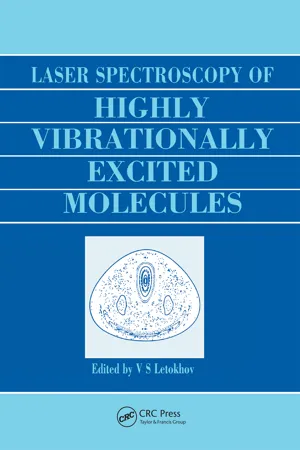
Laser Spectroscopy of Highly Vibrationally Excited Molecules
- 396 pages
- English
- ePUB (mobile friendly)
- Available on iOS & Android
Laser Spectroscopy of Highly Vibrationally Excited Molecules
About This Book
Laser spectroscopy has been perfected over the last fifteen years to become a precise tool for the investigation of highly vibrationally excited molecules. Intense infrared laser radiation permits both the multiple-photon resonant excitation and the dissociation of polyatomic molecules. In this book, the latest results of some of the foremost Soviet researchers are published for the first time in the West. Laser Spectroscopy of Highly Vibrationally Excited Molecules contains a comprehensive study of both the experimental and theoretical aspects of the basic photophysical interactions that occur in these processes. The book first focuses on the nonlinear interaction between the resonant vibrational mode and the intense infrared field and then examines the nonlinear interaction between the vibrational modes themselves due to anharmonicity. These interrelated processes determine all the characteristics of polyatomic molecules in an infrared field. The book also discusses related phenomena such as spectra broadening, optical resonance, photon echoes, and dynamical chaos. It includes examples of multiple-photon resonant excitation such as the excitation of OsO4 by CO^O2 laser radiation, which is detected by the visible luminescence that results. This book will be of great interest to researchers and postgraduate students in infrared laser spectroscopy and the laser chemistry of molecules and applications of isotope separation.
Frequently asked questions
1 Introduction to the Physics of Multiple-Photon Excitation of Vibrations in Polyatomic Molecules
1.1 Introduction

1.1.1 Methods of exciting high-lying vibrational levels
Table of contents
- Cover
- Half Title
- Title Page
- Copyright Page
- Contents
- List of Contributors
- Preface
- 1 Introduction to the Physics of Multiple-Photon Excitation of Vibrations in Polyatomic Molecules
- 2 Raman Spectroscopy of the Inter- and Intramolecular Vibrational Distribution in IR Multiple-Photon Excited Molecules
- 3 Spectra of Transitions in the Vibrational Quasicontinuum of Polyatomic Molecules
- 4 Dynamical Chaos and Intramolecular Vibrational Relaxation in Polyatomic Molecules
- 5 Laser IR Spectroscopy of Polyatomic Molecules Near and Above the Dissociation Limit
- 6 Inverse Electronic Relaxation Under IR Multiple-Photon Excitation of Molecules
- Index